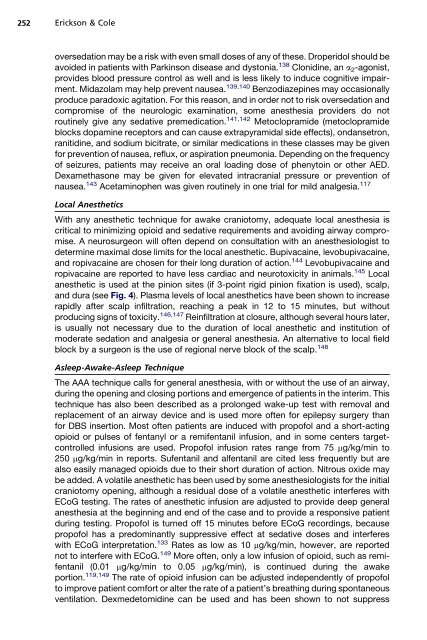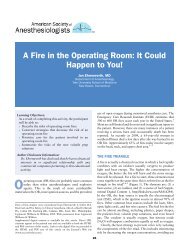Anesthetic Considerations for Awake Craniotomy for Epilepsy ... - Vtr
Anesthetic Considerations for Awake Craniotomy for Epilepsy ... - Vtr
Anesthetic Considerations for Awake Craniotomy for Epilepsy ... - Vtr
You also want an ePaper? Increase the reach of your titles
YUMPU automatically turns print PDFs into web optimized ePapers that Google loves.
252<br />
Erickson & Cole<br />
oversedation may be a risk with even small doses of any of these. Droperidol should be<br />
avoided in patients with Parkinson disease and dystonia. 138 Clonidine, an a2-agonist,<br />
provides blood pressure control as well and is less likely to induce cognitive impairment.<br />
Midazolam may help prevent nausea. 139,140 Benzodiazepines may occasionally<br />
produce paradoxic agitation. For this reason, and in order not to risk oversedation and<br />
compromise of the neurologic examination, some anesthesia providers do not<br />
routinely give any sedative premedication. 141,142 Metoclopramide (metoclopramide<br />
blocks dopamine receptors and can cause extrapyramidal side effects), ondansetron,<br />
ranitidine, and sodium bicitrate, or similar medications in these classes may be given<br />
<strong>for</strong> prevention of nausea, reflux, or aspiration pneumonia. Depending on the frequency<br />
of seizures, patients may receive an oral loading dose of phenytoin or other AED.<br />
Dexamethasone may be given <strong>for</strong> elevated intracranial pressure or prevention of<br />
nausea. 143 Acetaminophen was given routinely in one trial <strong>for</strong> mild analgesia. 117<br />
Local <strong>Anesthetic</strong>s<br />
With any anesthetic technique <strong>for</strong> awake craniotomy, adequate local anesthesia is<br />
critical to minimizing opioid and sedative requirements and avoiding airway compromise.<br />
A neurosurgeon will often depend on consultation with an anesthesiologist to<br />
determine maximal dose limits <strong>for</strong> the local anesthetic. Bupivacaine, levobupivacaine,<br />
and ropivacaine are chosen <strong>for</strong> their long duration of action. 144 Levobupivacaine and<br />
ropivacaine are reported to have less cardiac and neurotoxicity in animals. 145 Local<br />
anesthetic is used at the pinion sites (if 3-point rigid pinion fixation is used), scalp,<br />
and dura (see Fig. 4). Plasma levels of local anesthetics have been shown to increase<br />
rapidly after scalp infiltration, reaching a peak in 12 to 15 minutes, but without<br />
producing signs of toxicity. 146,147 Reinfiltration at closure, although several hours later,<br />
is usually not necessary due to the duration of local anesthetic and institution of<br />
moderate sedation and analgesia or general anesthesia. An alternative to local field<br />
block by a surgeon is the use of regional nerve block of the scalp. 148<br />
Asleep-<strong>Awake</strong>-Asleep Technique<br />
The AAA technique calls <strong>for</strong> general anesthesia, with or without the use of an airway,<br />
during the opening and closing portions and emergence of patients in the interim. This<br />
technique has also been described as a prolonged wake-up test with removal and<br />
replacement of an airway device and is used more often <strong>for</strong> epilepsy surgery than<br />
<strong>for</strong> DBS insertion. Most often patients are induced with propofol and a short-acting<br />
opioid or pulses of fentanyl or a remifentanil infusion, and in some centers targetcontrolled<br />
infusions are used. Propofol infusion rates range from 75 mg/kg/min to<br />
250 mg/kg/min in reports. Sufentanil and alfentanil are cited less frequently but are<br />
also easily managed opioids due to their short duration of action. Nitrous oxide may<br />
be added. A volatile anesthetic has been used by some anesthesiologists <strong>for</strong> the initial<br />
craniotomy opening, although a residual dose of a volatile anesthetic interferes with<br />
ECoG testing. The rates of anesthetic infusion are adjusted to provide deep general<br />
anesthesia at the beginning and end of the case and to provide a responsive patient<br />
during testing. Propofol is turned off 15 minutes be<strong>for</strong>e ECoG recordings, because<br />
propofol has a predominantly suppressive effect at sedative doses and interferes<br />
with ECoG interpretation. 133 Rates as low as 10 mg/kg/min, however, are reported<br />
not to interfere with ECoG. 149 More often, only a low infusion of opioid, such as remifentanil<br />
(0.01 mg/kg/min to 0.05 mg/kg/min), is continued during the awake<br />
portion. 119,149 The rate of opioid infusion can be adjusted independently of propofol<br />
to improve patient com<strong>for</strong>t or alter the rate of a patient’s breathing during spontaneous<br />
ventilation. Dexmedetomidine can be used and has been shown to not suppress




